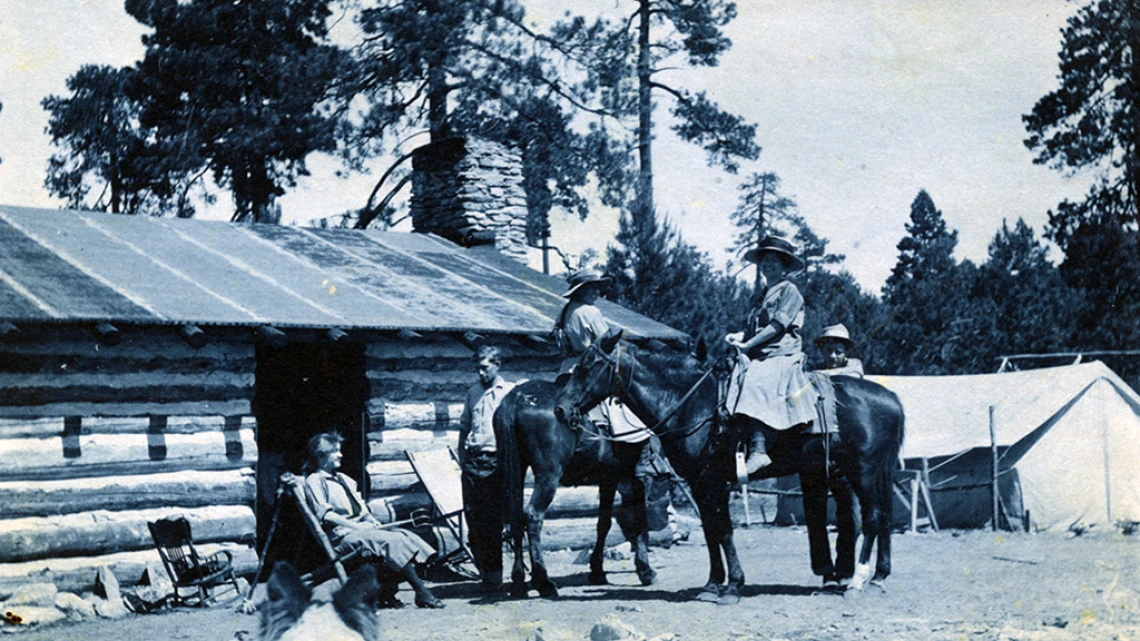Manning family collection

Camp Manning in Rincon Mountains, Tucson, Arizona, undated.
Collection area: Arizona and Southwest
Collection dates: circa 1860-1950s
The photographs in this collection primarily depict members of the family in formal and informal poses. There is little here that documents their activities as cattle farmers. A series of cynotypes from the early part of the 20th century documents the family's vacations at their camp in the Rincon Mountains. A series of panoramic photographs of Gussie Manning and members of the Elks Lodge was probably taken in the 1930s, rather than twenty years earlier, as the notation on the back of the prints.
The Manning Family was instrumental in the agricultural and urban development of Tucson and southern California during the late-nineteenth century. The family owned huge tracts of rich agricultural land in Arizona, California, and Mexico, were successful real estate developers, were active in local and national politics, and played a significant role in the growth of transportation technology in Tucson. Most of the family's fame and fortune was due to Levi Howard Manning, a kind of "Howard Hughes" figure of the southwest.
Levi Howard Manning (1864-1935) was born in Holly Springs, Mississippi in 1864. His father was a state senator and the family owned a successful plantation in Holly Springs. According to family legend, Levi arrived in Tucson with a scandal hot on his heels. In 1882, at the age of eighteen, Levi came home from college for spring vacation with a fraternity brother. There was a circus in town, and the two went, managing to free an elephant while there. The elephant subsequently ransacked the town. When Levi told his mother, she told Manning that he should leave town before his father found out about his escapade. Levi left town that day with a small amount of money from his mother and her best carriage horses. He arrived in Tucson in 1883 (some accounts say 1884), penniless. Manning's enterprising nature soon led him from a job hauling buckets of water to working as a reporter for the Tucson newspapers the Star and the Citizen. A few years later, Manning turned to agriculture and mining. He married Cordelia (Gussie) Lovell O'Connell, a renowned beauty and member of an established Tucson family.
The exact date of the rise of Manning's fortunes is unknown, but between his arrival in Tucson and his election as its 17th mayor, Manning managed to get involved in a variety of successful ventures. Manning and his business partners spent millions of dollars developing land in the Santa Cruz Valley, and built and equipped the Santa Rita Hotel. His involvement in the reorganization of Tucson Gas, Electric Light & Power Co. paved the way for the installation of power for a street railway system. Additionally, Manning discovered Signal Hill in California, a site of rich oil deposits. Under President Cleveland, Manning served as Surveyor Governor of Arizona Territory.
In 1906, Manning began his first venture into cattle farming with his purchase of what would become known as Scotch Farms, a 500 acre ranch between Tucson and the San Xavier Mission. Eight years later, in 1914, Manning bought the entire Canoa Land Grant, which at that time spanned west from the base of the Santa Rita Mountains across the Avra Valley (ca. 40,000 acres). After purchasing the ranch, Manning developed it into what was considered one of the finest cattle ranches in the southwest, running mostly Hereford cattle, but also breeding Arabian horses. In 1916, the southern half of the ranch was sold to the Intercontinental Rubber Company, which was at that time experimenting with the production of guayule as a wartime substitution for rubber. Manning later acquired land adjacent to the southern half of the Canoa, to create a ranch of nearly 100,000 acres, and began a scientific breeding program to improve the quality of his cattle.
In 1921, Manning's son, Howell (1899-1966) assumed the daily operation of the ranch. Howell had attended Culver Military Academy and Dartmouth College before joining the army as a machine gunner during World War I. Howell, who later became known as "Big Howell," leased or sold large portions of the Canoa ranch, mainly to finance a farming and ranching operation in Guaymas, Mexico. Howell was known as a sportsman and frequently went on long ocean fishing expeditions in Mexico. In the mid-1920s, Howell married Margaret Ferguson, and had two sons, Howell Jr. (killed in a car accident in 1951) and Marklan. The marriage lasted approximately ten years, and in 1933 Howell married his second wife, Evelyn. In 1935 the couple had a daughter, Clare (known as "Jinx").
In 1949, the family home, Paseo Redondo, was sold to the Tucson Elks Lodge (Levi H. Manning had been a member of the Lodge). The Elks owned the property until 1979, when it was sold to a local real estate developer. The house, located in downtown Tucson, still stands.
A collection guide explains what's in a collection. New to using our collections? Learn how to use a collection guide.
Collection guideAccess this collection
Visit us in person to access materials from this collection. Our materials are one-of-a-kind and require special care, so they can’t be checked out or taken home.
How to cite
Learn how to cite and use materials from Special Collections in your research.
